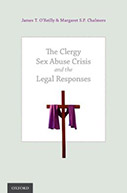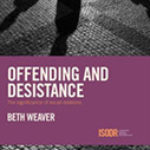The Clergy Sex Abuse Crisis and the Legal Responses

Authors: James T. O’Reilly and Margaret S. P. Chalmers
Publisher: New York; Oxford, UK: Oxford University Press, 2014. 472p.
Reviewer: Carolyn M. Warner | March 2015
In 2002, it came to light that Cardinal Bernard Law of Boston had gone so far as to allow his legal counsel to assert that a sixyear old victim was negligent and thus partly responsible for the sexual abuse he had suffered from a cleric. For many observers, including Catholics, this was beyond the pale. The legal and legalistic responses of the Catholic Church to the clergy child sex abuse crisis have been, to outside observers, astonishing, perplexing, and often disturbing. James T. O’Reilly and Margaret S.P. Chalmers, the former a legal scholar, the latter a canon lawyer and scholar, take readers through the American legal landscape, canon law, and Vatican policy in an effort to clarify the bases of the Church’s legal liability (or lack thereof) for clergy child sex abuse cases, the workings of canon law in such cases, and interactions with laws on religious freedom in the U.S., as well as civil legal procedures in clergy sex abuse cases. While not apologists for the Catholic Church, the authors shine a light on how and why cases have been handled as they have been by the Church, and by the US legal system. The book is as much a textbook for those in the legal profession, law enforcement and in the Catholic Church, who might have to deal with clergy sex abuse cases, as it is a work for Catholics, including clergy child sex abuse victims, and others, trying to understand the multiple facets of the legal side of clergy child sex abuse cases. The focus is on the legal context of the United States, though Vatican policy and international law affecting the Vatican’s authority over the Church in the US is also discussed, and other countries are mentioned when relevant.
Space does not permit a discussion of how or why individuals, the public, civil authorities, state legislatures and even the Church changed the way they dealt with clergy child sex abuse cases; O’Reilly and Chalmer’s first three parts give some sense of that, and contain extensive footnotes to useful sources for those wanting more information and analysis of particular topics. The rest of the book is a careful account and explanation of legal issues pertaining to the clergy, the Church as an institution, the victims, insurance companies, the Vatican and Canon law, with a detailed table of contents and thorough index. It constitutes an impressive, comprehensive description and analysis of, as the title says, the legal responses to the clergy child sex abuse crisis. For anyone involved in that, for scholars studying the subject, and even for those interested in challenges of religion-state legal arrangements, the book is well worth reading and it is truly a resource for those who might have to deal with such cases in the United States.
The complexity of the topic can be seen from the fact that the book is divided into four parts, and the fourth part, titled “Other Related Issues” accounts for over three-quarters of the book’s length. The first three parts, “Context and Background,” “Civil Litigation,” and “Handling Abuse Claims,” provide a useful introduction to those topics, describing the development of the clergy child sex abuse scandal in the U.S., and how these are typically litigated in US civil courts. Parts I-III also cover the difficulties of investigating and prosecuting clergy child sex abuse cases in civil courts. As the authors note, cases occasionally were reported to bishops and other Catholic officials in the decades preceding the 1980s, yet families and/or the child victim were often ashamed to mention the abuse, or did not want to be perceived as causing trouble (242-3). Further, when they did report, they often were not taken seriously (neither the victim by his or her family, nor the family by the Church). Victims and families rarely, if ever, reported the abuse to the police, and if they did, the response was usually the same as what the victim and family heard from the Church, “the priest wouldn’t do such a thing.” Civil authorities also viewed this as a matter best left to the Church, a response the Church preferred.
For various reasons, these patterns began to change in the 1980s, with the exposure of an egregious case of clergy child sex abuse involving Father Gilbert Gauthe and the failure of the Louisiana Church diocese to deal with the priest and his many victims. Largely due to the persistence of victims, their families, investigative journalists, attorneys, and the media, the massive scope of clergy child sex abuse in the US Catholic Church, and the Church’s failure to rein in the perpetrators and address victims’ needs, came to light, culminating in the bankruptcy of several large dioceses, the posting on-line of thousands of pages of Church files on child sex abusing clerics, the launch of a victim’s network that now has branches in a number of other countries, the creation of a website that provides an encyclopedic listing of child-sex-abusing clergy and related documents, and the extension of statutes of limitations on child sex abuse. Many have wondered how it came to pass that a religious institution that promotes its pastoral role could have deviated so far from it. After reading O’Reilly and Chalmers’ work, one might be tempted to conclude that it is because that pastoral role is, to its detriment, embodied in an institution that has its own legal system, and a peculiar corporate structure and legal status in US civil law.
For instance, O’Reilly and Chalmers point out that among the many reasons bishops failed to address allegations by victims and their families of clergy child sex abuse with a pastoral response, is that they basically “must choose between responses that can either be pastoral or financial but not both . . . . [F]or fear of harsher financial consequences in future possible jury trials, bishops are of advised by their defense lawyers to not meet with victims” (227). If they apologize, they run the risk that “this can be construed as a legal admission of guilt and may become the basis for liability in a civil court” (227). The situation is a Catch-22. Most victims who started to come forward in the 1980s and 1990s just wanted the bishop to apologize and the priest to be removed from further contact with children (228). When the Church didn’t respond, for the above legal and other reasons, the only recourse victims had was to go to civil authorities, reporting the abuse to the police and/or hiring an attorney who would pursue the Church in court for damages. The increasingly frequent success of such cases also increased the potential cost to the bishop of apologizing. Bishops didn’t, and thus victims more frequently went to court. By the early 2000s, the scales had tipped such that victims first turned to lawyers, not to their bishops. The latter were irrelevant in the victim getting a resolution. Financial consequences underlay the strategy of Cardinal Bernard Law’s legal defense counsel, mentioned above, in claiming the abused child was negligent. Though it is a common strategy in tort law (as well as defense in sexual assault cases) to blame the victim’s behavior for inducing some of the harm the victim incurred, giving priority to the legal and financial aspects of the case meant Cardinal Law lost whatever appearance might have been left of his pastoral role.
Where one might be tempted to think that U.S. constitutional protections of religion have prevented effective prosecution of child sex abusing priests, the authors document that that has not entirely been the case. Secular law against child sex abuse applies to the Catholic clergy (99), though there are some First Amendment protections. As other works have shown, and as the authors indicate (218-9), what instead may have prevented prosecution was a societal deference to the Church, and a tendency until fairly recently to view priests and the hierarchy as a privileged, trustworthy, even superior group of individuals, with the result that law enforcement officials left matters to the Church. For political and social reasons, those tendencies were compounded in cities where the Church was a dominant institution and dominated the lives of its adherents.
O’Reilly and Chalmers show, through analysis of case law, that, as one court put it, applying “a secular standard to secular conduct that is tortious is not prohibited by the Constitution” (93). A Connecticut court noted the Free Exercise Clause “might well prohibit this court from interfering in the manner in which the Diocese supervised a priest’s performance of Mass, or confession, but it certainly cannot prohibit a court from determining whether the Diocese should be liable for negligently allowing its employees to engage in sexual conduct with minor females” (94). In other words, civil authorities can investigate and prosecute dioceses for a variety of negligent behaviors. Where civil authorities may be obstructed is in obtaining documents that have been sent to any Vatican state offices—those are under cover of diplomatic immunity and in that way, the Catholic Church, unlike other religions, is able to block the reach of the state. Dioceses have also strategically used bankruptcy laws to protect themselves from large financial judgments, and at least one (Milwaukee) has moved assets out of the diocese in order to prevent those from being accessible in civil judgments and bankruptcy proceedings (that case is on appeal in the 7th Circuit). Most of the twelve US dioceses that have declared bankruptcy since 2000 did so just before the start of a set of civil trials. All assets are frozen, document discovery and church officials’ depositions blocked, the trial put on hold (and rarely restarted, when, years later, the bankruptcy is lifted), and settlements are much lower than the lawsuits likely would have won had they gone to trial. The authors also show that the Church has fought against so-called reporting laws, which have come to apply to almost every category of person/professional who might work with children. The Church’s claim is that if another priest or bishop learns of the abuse in the confessional, the sanctity of the confession prevents reporting and prevents compelling testimony about that confession. U.S. courts have established rather strict criteria for when such a confession is protected; confessions made by a priest in a confessional box appear to meet them (113-134, 160). To outside observers, this merely looks like the Church is using its theology to protect criminal child sex abusers. What makes a rather technical book an interesting read is that although it is these actions that anger victims and observers alike, O’Reilly and Chalmers even-handedly explain the legal and financial rationale behind them.
Canon law, within the context of a common law civil system in which priests can be prosecuted by public authorities and sued by their victims, compounds the Church’s ossified response to clergy child sex abuse. The authors do an excellent job of documenting and explaining how, even when bishops want to remove an offending priest from the priesthood, they may not be able to due to canon law procedures. For instance, when the Code of Canon Law was revised in 1983, “it had the effect of further limiting what priests were able to do under canon law to punish, remove, or laicize abusive priests” (239). By and large, bishops have to organize and conduct a penal trial under canon law, something with which they have had little or no training, and for which there has been a serious shortage of trained lawyers (263). The victim, except for testimony, is irrelevant to the proceedings, adding to the impression the Church gives of protecting the perpetrators. Verdicts can be appealed to Rome (377-8). All involved agree that the process is “’lengthy and cumbersome’” (269). The trial needs the participation of the accuser(s), who however may not wish to re-live the abuse, particularly in a context in which protections for victims of child sex abuse are lacking, procedures and rules of evidence are not clear (357-8), and newer procedures used in civil courts are not allowed (e.g., taped or remote video testimony so the victim does not have to face the alleged abuser) and/or at a time when the victim is already going through a civil trial. This then creates another Catch-22: the Church needs the victims to testify, but victims are reluctant to do so, so the Church does not proceed, because technically it can’t, in its own trial of the priest; thus, there is no way to remove the offending priest from the priesthood, making it seem the Church is doing nothing to deal with clergy child sex abusers. If a civil trial is on-going or anticipated, legal counsel for the diocese may suggest not proceeding with the canonical trial at the same time, since evidence disgorged in canonical proceedings potentially could be subpoenaed for the civil trial, and the civil lawyer for the victim may suggest not cooperating with the diocese for purposes of canonical proceedings, since that might contaminate the civil proceedings (396).
O’Reilly and Chalmers make clear the conundrum the Church, particularly the hierarchy, faces when trying to address clergy child sex abuse. What is less clear is in the book is that in Catholic theology, bishops are to act as Jesus. Thus, their protecting the institution and its finances at the expense of the faithful is not just bewildering to Catholics, it is a betrayal of a sacred office. Legal doctrine, including canon law, cannot deny or rectify that. The book indicates that canon law contains additional obstacles to addressing clergy child sex abuse. A final source of difficulty worth mentioning is that the Code of Canon Law stipulates that the structure of the Church shall have “no separation of powers” (208). The bishop holds executive, legislative and judicial power in his diocese, subject only to the Pope and the Code of Canon Law. Catholic theology privileges the clergy over the laity (152, 219-20). With this kind of structure, it is difficult for anyone inside the institution, except the Pope, to hold the hierarchy accountable. Institutional corruption is virtually inevitable, and of the sort seen in how the hierarchy has handled clergy child sex abuse. The authors make some suggestions for changes at the margins of canon law, noting also that Pope Francis has launched a review of the Code. They are realistic, though, and thus not optimistic that Church procedures will be revised in a timely manner that can meet the needs of victims, as well as of the accused (201-2, 403). And, as they conclude, the remedies for Catholic clergy child sex abuse cannot be found in legal responses alone. Catholic clergy child sex abuse victims, many of whom feel they have lost their souls, and not just their innocence, would agree.
Carolyn M. Warner is Professor of Political Science, School of Politics and Global Studies, Arizona State University, Tempe AZ 85287-3902


